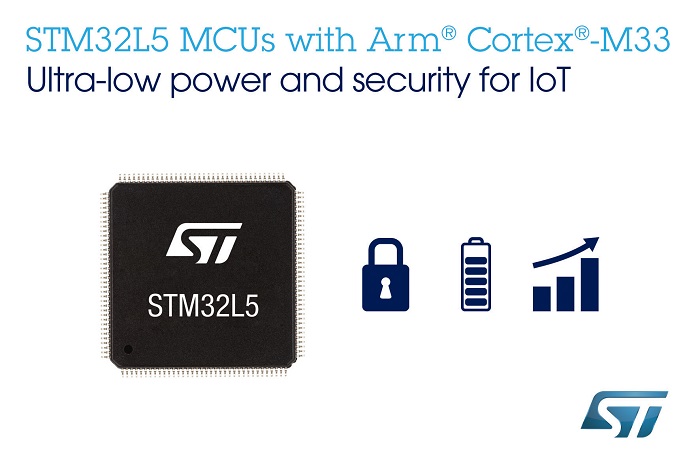By Gina Roos, editor-in-chief
STMicroelectronics has introduced its ultra-low-power STM32L5x2 microcontrollers (MCUs), based on Arm Cortex-M33 32-bit RISC core with Arm TrustZone hardware-based security, to offer better protection for IoT-connected applications. Trusted computing authenticates devices connected to a network by creating a protected execution environment for cyber-protection and sensitive code (cryptography and key storage) that blocks attempts to corrupt devices or software, while a second, independent execution environment allows for the running of untrusted code, said the company.
With the new STM32L5 series MCUs, operating at clock frequencies to 110 MHz, ST enables designers to include or exclude each I/O, peripheral, or area of flash or SRAM from TrustZone protection. This allows sensitive workloads to be fully isolated for maximum security, said ST.

In addition, TrustZone was engineered to support secure boot, special read-out and write protection for integrated SRAM and flash, and cryptographic acceleration, including AES 128-/256-bit key hardware acceleration, public key acceleration (PKA), and AES-128 on-the-fly decryption (OTFDEC), to protect external code or data. Other features include active tamper detection and secure firmware installation. Together, these security features deliver certification to PSA Certified Level 2.
The STM32L5 family also delivers ultra-low power thanks to the addition of techniques such as adaptive voltage scaling, real-time acceleration, power gating, and multiple reduced-power operating modes. These techniques enable the MCUs to deliver high performance and long runtimes whether the devices are powered by coin cells or even energy harvesting, said ST.
The switched-mode step-down regulator can also be powered up or down on the fly to improve low-power performance when the VDD voltage is high enough. The ULPMark scores, which measure ultra-low-power efficiency based on real-world benchmarks developed by EEMBC, are: 370 ULPMark-CoreProfile and 54 ULPMark-PeripheralProfile at 1.8 V.
Other MCU features include 512-Kbyte dual-bank Flash that allows read-while-write operation and supports error correction code (ECC) with diagnostics, a 256-Kbyte SRAM, and support for high-speed external memory including single, dual, quad, or octal SPI and Hyperbus flash or SRAM, as well as an interface for SRAM, PSRAM, NOR, NAND, or FRAM.
Digital peripherals include USB Full Speed with dedicated supply, which allows customers to keep USB communication even when the system is powered at 1.8 V, and a UCPD controller compliant with USB Type-C Rev. 1.2 and USB Power Delivery Rev. 3.0 specifications. Smart analog features include an analog-to-digital converter (ADC), two power-gated digital-to-analog converters (DACs), two ultra-low-power comparators, and two operational amplifiers with external or internal follower routing and programmable-gain amplifier (PGA) capability.
The STM32L5 series offers its own STM32CubeL5 one-stop-shop software package, which includes hardware abstraction layer and low-level drivers, FreeRTOS, Trusted Firmware-M (TF-M), Secure Boot and Secure Firmware Update (SBSFU), USB-PD device driver, MbedTLS and MbedCrypto, FatFS file system, and Touch Sensing drivers.
The STM32CubeL5 features more than 300 project examples that can run on the STM32L552E-EV evaluation board, the STM32L562E-DK discovery kit, and NUCLEO-L552ZE-Q .
The STM32L5x2 MCUs are well-suited for industrial IoT applications, including metering, health (human or machine) monitoring, and mobile point-of-sale. Starting at $2.60 in quantities of 1,000, the STM32L5x2 MCUs are in full production and available in standard temperature grade (−40°C to 85°C) for consumer and commercial applications or high-temperature grade specified from −40°C to 125°C.
Advertisement
Learn more about Electronic Products Magazine





